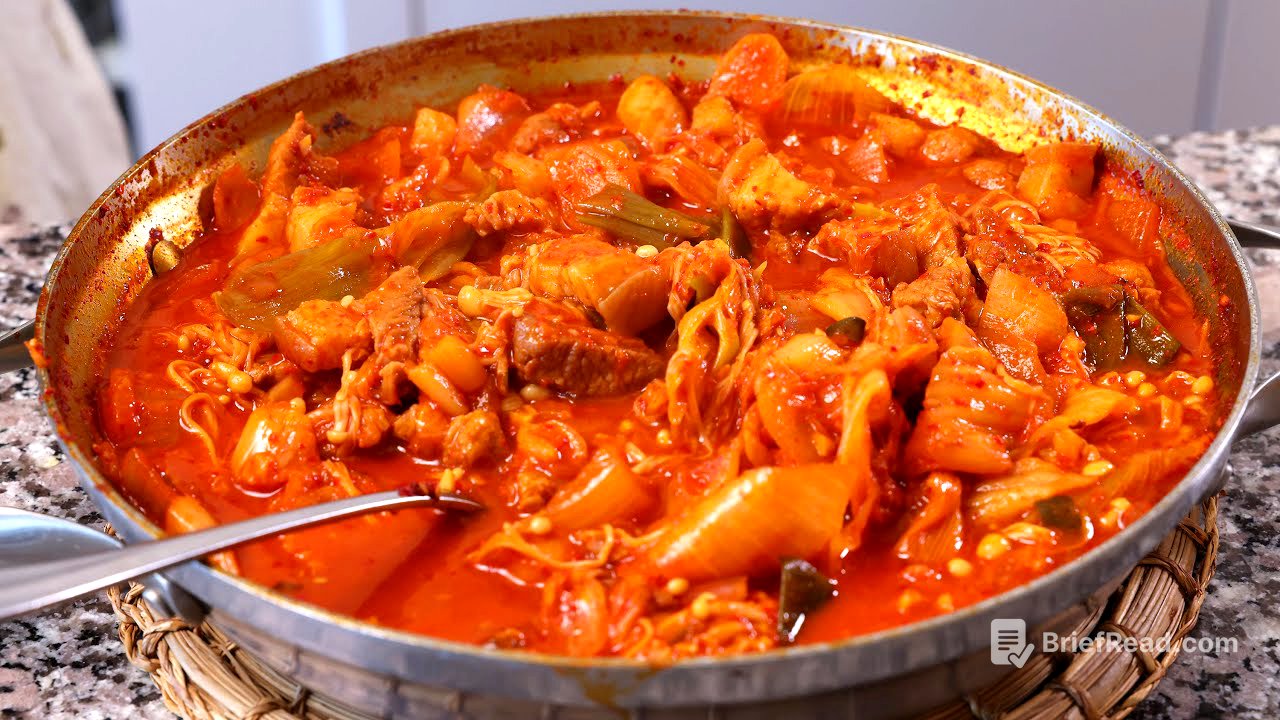TLDR;
Maangchi demonstrates how to make Dwaeji-Kimchi Duruchigi, a spicy Korean stir-fry featuring pork belly and well-fermented kimchi. The recipe includes vegetables and mushrooms, making it a perfect dish for a Korean food party. Key steps involve stir-frying pork belly with sesame oil and salt, adding chopped kimchi, and then incorporating a flavourful seasoning paste. The dish is simmered with water and additional vegetables, finished with mushrooms and sesame oil, and served with a variety of Korean side dishes.
- Uses pork belly and well-fermented kimchi.
- Includes a flavourful seasoning paste with gochujang and gochugaru.
- Simmered with vegetables and finished with mushrooms and sesame oil.
- Served with a variety of Korean side dishes for a complete meal.
Ingredients and Preparation [0:03]
Maangchi introduces Dwaeji-Kimchi Duruchigi, explaining that "duruchigi" means stir-fried with this and that. She plans to add vegetables and mushrooms to the dish, making it ideal for a party. The main ingredient is samgyeopsal, or pork belly, which she says has better flavour when stir-fried with kimchi. About one pound of pork belly is prepared by cleaning and cutting it.
Initial Stir-Frying of Pork [0:54]
Maangchi heats a pan and adds the pork belly to it. To enhance the flavour, she adds a little sesame oil and some salt. The pork is stirred over medium heat to ensure it cooks evenly without burning.
Kimchi Preparation [1:32]
While the pork is cooking, Maangchi prepares one pound of well-fermented kimchi. She chops the kimchi thinly. After the pork has cooked for about five to six minutes, absorbing the sesame oil and salt, the chopped kimchi is added to the pan.
Adding Kimchi and Making the Seasoning Paste [2:16]
The kimchi is added to the pork and allowed to cook. Maangchi then prepares the seasoning paste, combining two tablespoons of hot pepper paste (gochujang), one tablespoon of soy sauce, two tablespoons of hot pepper flakes (gochugaru), and about two tablespoons of water. She adds two tablespoons of rice syrup (jocheong) for a touch of sweetness, noting that it can be skipped for those avoiding sweeteners. Four garlic cloves are minced and added to the mixture.
Adding Vegetables and Simmering [4:28]
A large green onion (dae-pa) is cut diagonally and added to the pan, along with a medium-sized onion and a small carrot. The kimchi and vegetables are cooked together for about six to seven minutes over medium heat, with constant stirring. The seasoning paste is then added, along with one and a half cups of water. Maangchi explains that this dish is often served boiling on the table in Korean restaurants with various side dishes. The mixture is covered and cooked for 10 minutes.
Adding Mushrooms and Final Touches [6:11]
Maangchi prepares Enoki mushrooms (paengi-buseot), cutting off the bottom part and washing them. After 10 minutes, she checks the dish, noting it smells spicy. The mushrooms are added, along with about half a teaspoon of ground black pepper. The heat is turned off, and sesame oil is added as a final touch.
Serving and Enjoying the Dish [7:57]
Maangchi suggests that this dish is perfect for a Korean food party and demonstrates how to serve it with various side dishes prepared in advance. She adds rice and a fried egg to the plate, along with the stir-fried pork and kimchi. She recommends using a large spoon for sharing. She also shows how to eat it with Napa cabbage, cooked radish (mu-namul), spicy cucumber, steamed eggplant, soybean sprouts (kongnamul-muchim), and semi-dried salted fish. Maangchi encourages viewers to make the recipe and enjoy a Korean food party with family and friends.









